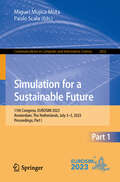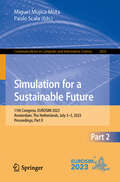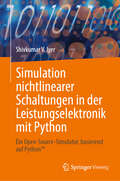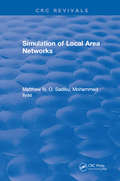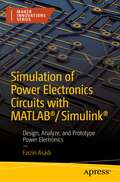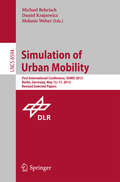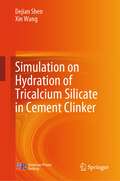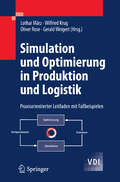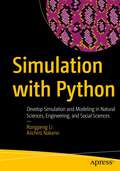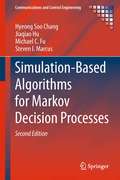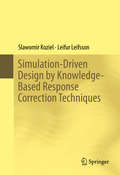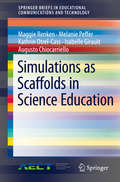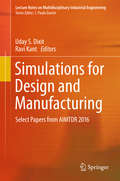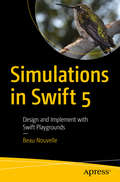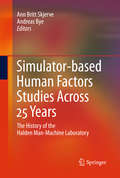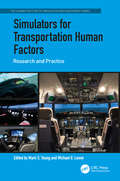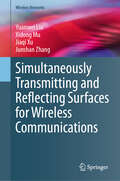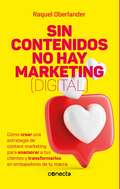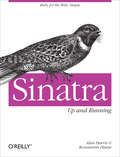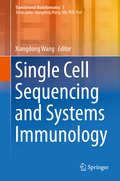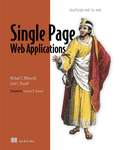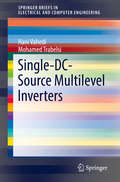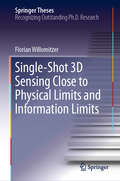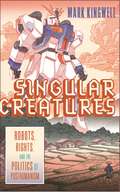- Table View
- List View
Simulation for a Sustainable Future: 11th Congress, EUROSIM 2023, Amsterdam, The Netherlands, July 3–5, 2023, Proceedings, Part I (Communications in Computer and Information Science #2032)
by Miguel Mujica Mota Paolo ScalaThe two volume set CCIS 2032 and 2033 constitutes the proceedings of the 11th Congress on Simulation for a Sustainable Future, EUROSIM 2023, which was held in Amsterdam, The Netherlands, during July 3–5, 2023. The 47 full papers included in the proceedings were carefully reviewed and selected from 99 submissions. The papers are divided in the following topical sections: environmental sustainability; healthcare; production systems; business and industries; logistics and transportation systems; monitor, control, and theoretical systems.
Simulation for a Sustainable Future: 11th Congress, EUROSIM 2023, Amsterdam, The Netherlands, July 3–5, 2023, Proceedings, Part II (Communications in Computer and Information Science #2033)
by Miguel Mujica Mota Paolo ScalaThe two volume set CCIS 2032 and 2033 constitutes the proceedings of the 11th Congress on Simulation for a Sustainable Future, EUROSIM 2023, which was held in Amsterdam, The Netherlands, during July 3–5, 2023. The 47 full papers included in the proceedings were carefully reviewed and selected from 99 submissions. The papers are divided in the following topical sections: environmental sustainability; healthcare; production systems; business and industries; logistics and transportation systems; monitor, control, and theoretical systems.
Simulation nichtlinearer Schaltungen in der Leistungselektronik mit Python: Ein Open-Source-Simulator, basierend auf Python™
by Shivkumar V. IyerDieses Buch bietet eine eingehende Diskussion zur Schaltungssimulation, indem es grundlegende elektrische Schaltungstheorie mit Python-Programmierung kombiniert. Es schließt eine Informationslücke, indem es die Entwicklung von Python Power Electronics beschreibt, einer Open-Source-Software zur Simulation von Schaltungen, und ihre Anwendung anhand eines Beispiels zeigt. Im Gegensatz zu typischen Büchern über Schaltungstheorie, die beschreiben, wie Schaltungen mathematisch gelöst werden können, gefolgt von Beispielen zur Simulation unter Verwendung spezifischer kommerzieller Software, verfolgt dieses Buch einen anderen Ansatz. Der Autor beschreibt zunächst jeden Aspekt der Open-Source-Software im Kontext nichtlinearer Leistungselektronikschaltungen. Dies dient als Grundlage für angehende oder praktizierende Ingenieure, um die Entwicklung von Open-Source-Software für verschiedene Zwecke voranzutreiben. Durch die explizite Demonstration des Betriebs der Software mittels Algorithmen vereint dieses Buch die Gebiete Elektrotechnik und Softwaretechnologie.
Simulation of Local Area Networks
by Matthew N. SadikuA fast-growing area in the communications industry is the internetworking of an ever-increasing proliferation of computers, particularly via local area networks (LANs). The LAN is a resource-sharing data communications network being used by many offices to interchange information such as electronic mail, word processing, and files among computers and other devices. This unique book shows the user how to establish the performance characteristics of a LAN before putting it to use in a particular type of situation. Simulation of Local Area Networks consists of eight chapters, each with its own extensive list of references. The first chapter provides a brief review of local area networks, and the second chapter gives the analytical models of popular LANs-token-passing bus and ring networks, CSMA/CD LANs, and star networks. Chapter 3 covers general principles of simulation, and Chapter 4 discusses fundamental concepts in probability and statistics relating to simulation modeling. Materials in Chapters 3 and 4 are specifically applied in developing simulation models on token-passing LANs, CSMA/CD LANs, and star LANs in Chapters 5 through 7. The computer code in Chapters 5, 6, and 7 is divided into segments, and a detailed explanation of each segment is provided. The last chapter reviews special-purpose languages such as GPSS, SIMSCRIPT, GASP, SIMULA, SLAM, and RESQ. Helpful criteria for language selection are included. The entire code is put together in the appendixes. This book has two major advantages over existing texts. First, it uses C, a well-developed general-purpose language that is familiar to most analysts. Second, the text specifically applies the simulation principles to local area networks. No other book available shows the systems analyst how to evaluate the performance of existing or proposed systems under different kinds of conditions.
Simulation of Power Electronics Circuits with MATLAB®/Simulink®: Design, Analyze, and Prototype Power Electronics (Maker Innovations Ser.)
by Farzin AsadiDesign and analyze electronic components and systems with the help of powerful software and effective skillsets. Balancing theory with practical exploration of the relevant software, you'll start solving power electronics problems like a pro. Using MATLAB®/Simulink®, you'll analyze the circuit in a laptop charger; interface with the power electronics converter controlling a washing machine's motor; turn on lamps with an electronic ballast; convert AC into DC power; and more!Power electronics are at the bedrock of all the wonderful devices simplifying our daily life. Designing them isn't just about understanding schematics. It also requires measuring twice and cutting once. In order to save time and money, a power electronics circuit must be simulated before construction. So you'll learn how to work with one of the most powerful simulation tools for this purpose. That way you'll know before you even go to make it whether the circuit works as expected. Learn to work with MATLAB®/Simulink® by directly applying and building the projects in this book. Or use it as a lab manual for power electronics and industrial electronics. Either way, using strong simulations and solid design theory, you'll be able to build power electronics that don't fail. What You'll LearnSimulate power electronics effectively before building themSelect suitable semiconductor components for your circuit based on simulation waveformsExtract dynamic models of converters and design suitable controllers for themWho This Book Is ForEngineers and students who want to simulate power electronics circuits in MATLAB®/Simulink®.
Simulation of Urban Mobility
by Michael Behrisch Daniel Krajzewicz Melanie WeberThis book constitutes the thoroughly refereed proceedings of the First International Conference on Simulation of Urban Mobility, SUMO 2013, held in Berlin, Germany, in May 2013. The 12 revised full papers presented tin this book were carefully selected and reviewed from 22 submissions. The papers are organized in two topical sections: models and technical innovations and applications and surveys.
Simulation on Hydration of Tricalcium Silicate in Cement Clinker
by Xin Wang Dejian ShenThis book is written based on authors' research on cement hydration during the past decade. It establishes simulation model to evaluate the influence of crystal defects on the dissolution of tricalcium silicate and morphology change of particles and explores the hydration kinetics and microstructure development of tricalcium silicate under the mixed control of dissolution, diffusion, as well as boundary nucleation and growth. It also provides a theoretical basis for regulating the microstructure and performance of cement-based materials. It is designed as a reference work for professionals or practitioners and as a textbook for undergraduates or postgraduates. This book provides valuable knowledge and useful methods that can be applied in the field of cement hydration.
Simulation und Optimierung in Produktion und Logistik
by Lothar März Gerald Weigert Oliver Rose Wilfried KrugDie simulationsgestützte Optimierung von Produktportfolios und Produktionsketten birgt großes Potenzial - Berichte über Kopplungen von Simulation und Optimierung sind aber rar. Der Band liefert erstmals deutschsprachige Anwendungsbeispiele und einen Überblick über die Möglichkeiten von Simulation und Optimierung. Anders als standardisierte Planungsansätze können mithilfe der Simulation auch dynamische Produktions- und Logistikprozesse analysiert werden. Bei gezielter Vernetzung von Logistikabläufen lassen sich so unerwünschte Liegezeiten vermeiden.
Simulation with Python: Develop Simulation and Modeling in Natural Sciences, Engineering, and Social Sciences
by Rongpeng Li Aiichiro NakanoUnderstand the theory and implementation of simulation. This book covers simulation topics from a scenario-driven approach using Python and rich visualizations and tabulations. The book discusses simulation used in the natural and social sciences and with simulations taken from the top algorithms used in the industry today. The authors use an engaging approach that mixes mathematics and programming experiments with beginning-intermediate level Python code to create an immersive learning experience that is cohesive and integrated. After reading this book, you will have an understanding of simulation used in natural sciences, engineering, and social sciences using Python.What You'll LearnUse Python and numerical computation to demonstrate the power of simulationChoose a paradigm to run a simulationDraw statistical insights from numerical experimentsKnow how simulation is used to solve real-world problems Who This Book Is ForEntry-level to mid-level Python developers from various backgrounds, including backend developers, academic research programmers, data scientists, and machine learning engineers. The book is also useful to high school students and college undergraduates and graduates with STEM backgrounds.
Simulation-Based Algorithms for Markov Decision Processes
by Hyeong Soo Chang Steven I. Marcus Michael C. Fu Jiaqiao HuMarkov decision process (MDP) models are widely used for modeling sequential decision-making problems that arise in engineering, economics, computer science, and the social sciences. Many real-world problems modeled by MDPs have huge state and/or action spaces, giving an opening to the curse of dimensionality and so making practical solution of the resulting models intractable. In other cases, the system of interest is too complex to allow explicit specification of some of the MDP model parameters, but simulation samples are readily available (e.g., for random transitions and costs). For these settings, various sampling and population-based algorithms have been developed to overcome the difficulties of computing an optimal solution in terms of a policy and/or value function. Specific approaches include adaptive sampling, evolutionary policy iteration, evolutionary random policy search, and model reference adaptive search. This substantially enlarged new edition reflects the latest developments in novel algorithms and their underpinning theories, and presents an updated account of the topics that have emerged since the publication of the first edition. Includes: innovative material on MDPs, both in constrained settings and with uncertain transition properties; game-theoretic method for solving MDPs; theories for developing roll-out based algorithms; and details of approximation stochastic annealing, a population-based on-line simulation-based algorithm. The self-contained approach of this book will appeal not only to researchers in MDPs, stochastic modeling, and control, and simulation but will be a valuable source of tuition and reference for students of control and operations research.
Simulation-Driven Design by Knowledge-Based Response Correction Techniques
by Leifur Leifsson Slawomir KozielFocused on efficient simulation-driven multi-fidelity optimization techniques, this monograph on simulation-driven optimization covers simulations utilizing physics-based low-fidelity models, often based on coarse-discretization simulations or other types of simplified physics representations, such as analytical models. The methods presented in the book exploit as much as possible any knowledge about the system or device of interest embedded in the low-fidelity model with the purpose of reducing the computational overhead of the design process. Most of the techniques described in the book are of response correction type and can be split into parametric (usually based on analytical formulas) and non-parametric, i. e. , not based on analytical formulas. The latter, while more complex in implementation, tend to be more efficient. The book presents a general formulation of response correction techniques as well as a number of specific methods, including those based on correcting the low-fidelity model response (output space mapping, manifold mapping, adaptive response correction and shape-preserving response prediction), as well as on suitable modification of design specifications. Detailed formulations, application examples and the discussion of advantages and disadvantages of these techniques are also included. The book demonstrates the use of the discussed techniques for solving real-world engineering design problems, including applications in microwave engineering, antenna design, and aero/hydrodynamics.
Simulations as Scaffolds in Science Education
by Maggie Renken Melanie Peffer Kathrin Otrel-Cass Isabelle Girault Augusto ChiocarrielloThis book outlines key issues for addressing the grand challenges posed to educators, developers, and researchers interested in the intersection of simulations and science education. To achieve this, the authors explore the use of computer simulations as instructional scaffolds that provide strategies and support when students are faced with the need to acquire new skills or knowledge. The monograph aims to provide insight into what research has reported on navigating the complex process of inquiry- and problem-based science education and whether computer simulations as instructional scaffolds support specific aims of such pedagogical approaches for students.
Simulations for Design and Manufacturing: Select Papers From Aimtdr 2016 (Lecture Notes On Multidisciplinary Industrial Engineering)
by Uday S. Dixit Ravi KantThis book focuses on numerical simulations of manufacturing processes, discussing the use of numerical simulation techniques for design and analysis of the components and the manufacturing systems. Experimental studies on manufacturing processes are costly, time consuming and limited to the facilities available. Numerical simulations can help study the process at a faster rate and for a wide range of process conditions. They also provide good prediction accuracy and deeper insights into the process. The simulation models do not require any pre-simulation, experimental or analytical results, making them highly suitable and widely used for the reliable prediction of process outcomes. The book is based on selected proceedings of AIMTDR 2016. The chapters discuss topics relating to various simulation techniques, such as computational fluid dynamics, heat flow, thermo-mechanical analysis, molecular dynamics, multibody dynamic analysis, and operational modal analysis. These simulation techniques are used to: 1) design the components, 2) to investigate the effect of critical process parameters on the process outcome, 3) to explore the physics of the process, 4) to analyse the feasibility of the process or design, and 5) to optimize the process. A wide range of advanced manufacturing processes are covered, including friction stir welding, electro-discharge machining, electro-chemical machining, magnetic pulse welding, milling with MQL (minimum quantity lubrication), electromagnetic cladding, abrasive flow machining, incremental sheet forming, ultrasonic assisted turning, TIG welding, and laser sintering. This book will be useful to researchers and professional engineers alike.
Simulations in Swift 5: Design and Implement with Swift Playgrounds
by Beau NouvelleDesign and implement simulations using Apples Swift Playgrounds. Computer simulations are used to replicate the physical systems we see all around us. They help us solve problems by performing experiments that may otherwise be impossible in the real world. This book uses simulations to solve counter-intuitive logic puzzles, create procedural artworks, and build habitats for digital lifeforms. To help you create your own simulations using the Swift programming language, this book is filled with projects that you can easily follow along with. All you need is a Mac with the latest version of Xcode installed. All projects are written in Xcode’s Playgrounds. This keeps the process simple. No need to setup an Apple account, or learn anything further about building apps.Simulations are used in many areas within computer science and yet, barely anyone is teaching them. Sure, the fundamentals are in algorithm design, but simulations are a step above that. Usually when writing an algorithm you have a specific outcome in mind. However, when you create a simulation, the system you are modelling can be far more unpredictable than sorting a list, or navigating a maze. Simulations in Swift 5 will guide you through all of this.What You'll LearnSimulate situations with advanced algorithms to solve advanced problemsIncorporate real-world physics into simulated problemsPredict biological and other systems behavior and the outcome of events based on presented factorsWho This Book Is ForSwift programmers interested in tackling fun projects in Swift involving advanced algorithms and factors
Simulator-based Human Factors Studies Across 25 Years
by Ann Britt Skjerve Andreas ByeThe Halden Man-Machine Laboratory (HAMMLAB) has been at the heart of human factors research at the OECD Halden Reactor Project (HRP). The HRP is sponsored by a group of national organizations, representing nuclear power plant regulators, utilities, and research institutions. The HRP is hosted by the Institute for Energy Technology (IFE) in Halden, Norway. HAMMLAB comprises three full-scale nuclear power plant control room research simulators. The simulator studies performed in HAMMLAB have traditionally been experimental in nature. In a simulator it is possible to study events as they unfold in real time, in a highly realistic operational environment under partially controlled conditions. This means that a wide range of human factors issues, which would be impossible or highly impracticable to study in real-life settings, can thus be addressed in HAMMLAB. Simulator-based Human Factors Studies Across 25 Years celebrates the twenty-fifth anniversary of HAMMLAB by reviewing the human factors studies performed in HAMMLAB across this time-span. A range of human factors issues have been addressed, including: * human-system interfaces; * alarm systems; * computerized procedures; * human-automation interaction; * staffing, teamwork and human reliability. The aim of HAMMLAB studies has always been the same: to generate knowledge for solving current and future challenges in nuclear power plant operation to contribute to safety. The outcomes of HAMMLAB studies have been used to support design and assessment of nuclear power plant control rooms.
Simulators for Transportation Human Factors: Research and Practice (The Human Factors of Simulation and Assessment Series)
by Mark Young Michael LennéSimulation continues to be a growth area in transportation human factors. From empirical studies in the laboratory to the latest training techniques in the field, simulators offer myriad benefits for the experimenter and the practitioner. This book draws together current trends in research and training simulators for the road, rail, air and sea sectors to inform the reader how to maximize both validity and cost-effectiveness in each case. Simulators for Transportation Human Factors provides a valuable resource for both researchers and practitioners in transportation human factors on the use of simulators, giving readers concrete examples and case studies of how simulators have been developed and used in empirical research as well as training applications. It offers useful and usable information on the functional requirements of simulators without the need for any background knowledge on the technical aspects, focusing on the state of the art of research and applications in transport simulators rather than the state of the art of simulation technology. The book covers simulators in operational terms instead of task simulation/modelling and provides a useful balance between a bottom-up, academic approach and a top-down, practical perspective.
Simultaneously Transmitting and Reflecting Surfaces for Wireless Communications (Wireless Networks)
by Junshan Zhang Yuanwei Liu Xidong Mu Jiaqi XuThis book begins with discussing the fundamentals of Simultaneously Transmitting and Reflecting Surfaces (STARS) from the electromagnetic (EM) and communication perspectives. The basic signal and channel models for employing STARS in wireless communications is introduced as well. Then, the different categories and possible hardware implementation of STARS are highlighted. Next, the authors focus on attention to the STARS-aided wireless communications. The authors provide a comprehensive performance analysis of STARS with the outage probability, diversity gain and power scaling laws. Moreover, the operating protocols and corresponding beamforming design of STARS are discussed under different phase-shift models. As a further advance, the application of machine learning tools in STAR-aided wireless communications is introduced for addressing the beamforming design and resource allocation problems. The novel STARS-aided integrated sensing and communications (ISAC) in future wireless networks are also discussed with several case studies. Within this book, readers will find an extensive exploration of the STARS concept. The content encompasses a thorough survey of STARS research, covering principles, implementation, performance evaluation and applications. By presenting a comprehensive review of the STARS family, this book serves as a valuable resource for gaining insight into the complete pipeline of STARS research. Finally, the authors conclude the book by highlighting several future research directions for STARS. This book targets graduate, undergraduate, and postgraduate students as well as researchers working in wireless communications. Wireless communication engineers in industry and government will also want to purchase this book.
Sin contenidos no hay marketing (digital)
by Raquel OberlanderCómo crear una estrategia de content marketing para enamorar a tus clientes y transformarlos en embajadores de tu marca. El mundo cambió. Los seres humanos cambiamos. El marketing también debe hacerlo. Y para eso solo hay un camino: los contenidos, que permiten entregar valor real a las personas. Hacer marketing de contenidos es mucho más que levantarse un día y subir un post a Instagram o un video a TikTok. Es definir una estrategia, trazar un plan y ejecutarlo. Un proceso que implica muchísimas etapas, tareas, canales, tácticas, roles y saberes, que Raquel Oberlander tuvo la capacidad de condensar en un modelo al que bautizó HEPIC 10 y que comparte con infinita generosidad en este libro. Crear contenidos obliga a las organizaciones a definir un propósito que va mucho más allá de las ventas y la rentabilidad. Obliga a mirar el alma, en lugar de mirarse el ombligo. Y luego entregar aquello que se descubre en forma de mensajes que no interrumpan lo que las personas están viendo, sino que sean lo que quieren ver (o leer o escuchar). Sin contenidos no hay marketing (digital) está dedicado a profesionales de marketing y comunicación, pero también a los CEO, gerentes, emprendedores, músicos, abogados, contadores, coaches, porque, de una manera u otra, todos necesitamos generar contenido para promover el crecimiento de nuestros proyectos y de nuestra marca personal. Y también es ideal para los creadores de contenido, ya sean productores audiovisuales, diseñadores gráficos, redactores, influencers, freelancers, community managers, que son los aliados clave y grandes protagonistas en este proceso.
Sinatra: Ruby for the Web, Simply
by Alan Harris Konstantin HaaseTake advantage of Sinatra, the Ruby-based web application library and domain-specific language used by Heroku, GitHub, Apple, Engine Yard, and other prominent organizations. With this concise book, you will quickly gain working knowledge of Sinatra and its minimalist approach to building both standalone and modular web applications.Sinatra serves as a lightweight wrapper around Rack middleware, with syntax that maps closely to functions exposed by HTTP verbs, which makes it ideal for web services and APIs. If you have experience building applications with Ruby, you’ll quickly learn language fundamentals and see under-the-hood techniques, with the help of several practical examples. Then you’ll get hands-on experience with Sinatra by building your own blog engine.Learn Sinatra’s core concepts, and get started by building a simple applicationCreate views, manage sessions, and work with Sinatra route definitionsBecome familiar with the language’s internals, and take a closer look at RackUse different subclass methods for building flexible and robust architecturesPut Sinatra to work: build a blog that takes advantage of service hooks provided by the GitHub API
Single Cell Sequencing and Systems Immunology
by Xiangdong WangThe volume focuses on the genomics, proteomics, metabolomics, and bioinformatics of a single cell, especially lymphocytes and on understanding the molecular mechanisms of systems immunology. Based on the author's personal experience, it provides revealing insights into the potential applications, significance, workflow, comparison, future perspectives and challenges of single-cell sequencing for identifying and developing disease-specific biomarkers in order to understand the biological function, activation and dysfunction of single cells and lymphocytes and to explore their functional roles and responses to therapies. It also provides detailed information on individual subgroups of lymphocytes, including cell characters, function, surface markers, receptor function, intracellular signals and pathways, production of inflammatory mediators, nuclear receptors and factors, omics, sequencing, disease-specific biomarkers, bioinformatics, networks and dynamic networks, their role in disease and future prospects. Dr. Xiangdong Wang is a Professor of Medicine, Director of Shanghai Institute of Clinical Bioinformatics, Director of Fudan University Center for Clinical Bioinformatics, Director of the Biomedical Research Center of Zhongshan Hospital, Deputy Director of Shanghai Respiratory Research Institute, Shanghai, China.
Single Page Web Applications: JavaScript end-to-end
by Michael Mikowski Josh PowellSummaryIn Single Page Web Applications you'll learn to build modern browser-based apps that take advantage of stronger client platforms and more predictable bandwidth. You'll learn the SPA design approach, and then start exploring new techniques like structured JavaScript and responsive design. And you'll learn how to capitalize on trends like server-side JavaScript and NoSQL data stores, as well as new frameworks that make JavaScript more manageable and testable as a first-class language.About this BookIf your website is a jumpy collection of linked pages, you are behind. Single page web applications are your next step: pushing UI rendering and business logic to the browser and communicating with the server only to synchronize data, they provide a smooth user experience, much like a native application. But, SPAs can be hard to develop, manage, and test.Single Page Web Applications shows how your team can easily design, test, maintain, and extend sophisticated SPAs using JavaScript end-to-end, without getting locked into a framework. Along the way, you'll develop advanced HTML5, CSS3, and JavaScript skills, and use JavaScript as the language of the web server and the database.This book assumes basic knowledge of web development. No experience with SPAs is required.Purchase of the print book includes a free eBook in PDF, Kindle, and ePub formats from Manning Publications.What's InsideDesign, build, and test a full-stack SPABest-in-class tools like jQuery, TaffyDB, Node.js, and MongoDBReal-time web with web sockets and Socket.IOTouch controls for tablets and smartphonesCommon SPA design mistakesAbout the AuthorsThe authors are architects and engineering managers. Michael Mikowski has worked on many commercial SPAs and a platform that processes over 100 billion requests per year. Josh Powell has built some of the most heavily trafficked sites on the web.Table of ContentsPART 1: INTRODUCING SPASOur first single page applicationReintroducing JavaScriptPART 2: SPA CLIENTDevelop the ShellAdd feature modulesBuild the ModelFinish the Model and Data modulesPART 3: THE SPA SERVERThe web serverThe server databaseReadying our SPA for production
Single and Forced to Mingle: A Guide for (Nearly) Any Socially Awkward Situation
by Melissa Croce&“Hilarious.&” —Cosmopolitan A laugh-out-loud, tongue-in-cheek guidebook filled with hilarious and helpful advice—from how to dodge family members&’ unwanted questions about babies to successfully creating a fake partner during wedding season—for anyone trying to survive and thrive in the midst of singledom. Perfect for fans of Hey Ladies! and Single State of Mind.So, you&’re single. Whether existing sans partner is a new state of being or you&’ve been on this solo journey for a while, the fact of the matter is this: being single is actually awesome. You can do whatever you want, travel wherever you want, and be your truest, most free self. But there are a lot of people out there—your mom, your married best friend, the wedding industry, society—who see things differently. To them, singledom is something to avoid at all cost, no matter how many times you tell them you love your life the way it is. The limit does not exist when it comes to telling Aunt Carol you still don&’t want to be set up with her neighbor&’s ex-stepson. Now, Melissa Croce gives you the tips, tricks, and sage advice you need to graciously endure all of the cringe-worthy scenarios your single self may dread, from awkward small talk with an ex to navigating well-meaning but insensitive relatives. And it helps you truly flourish in your singledom, offering activities like quizzes aimed at helping you find a new hobby and tarot spreads for that cozy Saturday night in. Part real-world guide, part commiseration, and part celebration, Single and Forced to Mingle will steer you through the ups and downs of being single, reminding you just how good it feels to be free.
Single-DC-Source Multilevel Inverters (SpringerBriefs in Electrical and Computer Engineering)
by Hani Vahedi Mohamed TrabelsiThe purpose of the book is to distinguish the single-de-source multilevel inverter topologies and to teach their control, switching and voltage balancing. It will include new information on voltage balancing and control of multilevel inverters. The book will answer some important questions about the revolution of power electronics converters: 1- Why multilevel inverter are better than 2-level ones? 2- Why single-de-source multilevel inverters are a matter of interest? 3- What are the redundant switching states and what do they do? 4- How to use redundant switching states in control and voltage balancing? 5- What are the applications of single-de-source multilevel inverters?
Single-Shot 3D Sensing Close to Physical Limits and Information Limits (Springer Theses)
by Florian WillomitzerThis thesis discusses the physical and information theoretical limits of optical 3D metrology, and, based on these principal considerations, introduces a novel single-shot 3D video camera that works close to these limits. There are serious obstacles for a “perfect” 3D-camera: The author explains that it is impossible to achieve a data density better than one third of the available video pixels. Available single-shot 3D cameras yet display much lower data density, because there is one more obstacle: The object surface must be “encoded” in a non-ambiguous way, commonly by projecting sophisticated patterns. However, encoding devours space-bandwidth and reduces the output data density. The dissertation explains how this profound dilemma of 3D metrology can be solved, exploiting just two synchronized video cameras and a static projection pattern.The introduced single-shot 3D video camera, designed for macroscopic live scenes, displays an unprecedented quality and density of the 3D point cloud. The lateral resolution and depth precision are limited only by physics. Like a hologram, each movie-frame encompasses the full 3D information about the object surface and the observation perspective can be varied while watching the 3D movie.
Singular Creatures: Robots, Rights, and the Politics of Posthumanism
by Mark KingwellAnxiety about non-human intelligent machines is a longstanding theme of cultural production and consumption. Examples range from tales of golems and Frankenstein’s monster to the evil overlord scenarios of contemporary film and television franchises: Star Trek, the Alien series, and the Terminator sequence, as well as Her, Black Mirror, Blade Runner, Ex Machina, and many other less mainstream cultural artifacts. The source of this anxiety is clear. Non-human conscious entities may turn out to be superior to any biological form of life, allowing a stride across human ambition in a moment dubbed “the Singularity” by AI insiders. This is the turning point when non-human entities advance and reproduce in a manner that surpasses and subjugates biological forms of intelligent life. Although today’s artificial intelligences fall notably short of this level of sophistication, Mark Kingwell argues that we are already more than human in important ways, and likely to become more so as time goes on. In Singular Creatures Kingwell plumbs the depths of cultural and political meaning in the apparent transition to posthuman life. Our immersion in technology, now comprehensive to the point of invisibility, has altered forever what it means to be alive. The politics of posthumanism flow directly from our own situation, at once dependent on technology and afraid of its effects on current and future experiences.More than a century after playwright Karel Čapek coined the word robot – rooted in the Czech robota, meaning “servitude” or “drudgery” – in his 1920 allegory about the alienation of forced labour leading to a violent workers’ revolt, Čapek’s central question continues to haunt us. Can humans and their own creations co-exist in a new cyberflesh world, or is a struggle for superiority inevitable? Singular Creatures is an attempt at sketching the field before any deadly battle is joined.
